ASUS Z97-DELUXE (NFC & WLC) Review: With Two Thunderbolt 2 Too
by Ian Cutress on May 16, 2014 11:00 AM EST- Posted in
- Motherboards
- Intel
- Asus
- NFC
- 802.11ac
- Thunderbolt 2
- Z97
- Wireless Charging
Real World CPU Benchmarks
Readers of our motherboard review section will have noted the trend in modern motherboards to implement a form of MultiCore Enhancement / Acceleration / Turbo (read our report here) on their motherboards. This does several things – better benchmark results at stock settings (not entirely needed if overclocking is an end-user goal), at the expense of heat and temperature, but also gives in essence an automatic overclock which may be against what the user wants. Our testing methodology is ‘out-of-the-box’, with the latest public BIOS installed and XMP enabled, and thus subject to the whims of this feature. It is ultimately up to the motherboard manufacturer to take this risk – and manufacturers taking risks in the setup is something they do on every product (think C-state settings, USB priority, DPC Latency / monitoring priority, memory subtimings at JEDEC). Processor speed change is part of that risk which is clearly visible, and ultimately if no overclocking is planned, some motherboards will affect how fast that shiny new processor goes and can be an important factor in the purchase.
Rendering – Adobe After Effects CS6: link
Published by Adobe, After Effects is a digital motion graphics, visual effects and compositing software package used in the post-production process of filmmaking and television production. For our benchmark we downloaded a common scene in use on the AE forums for benchmarks and placed it under our own circumstances for a repeatable benchmark. We generate 152 frames of the scene and present the time to do so based purely on CPU calculations.
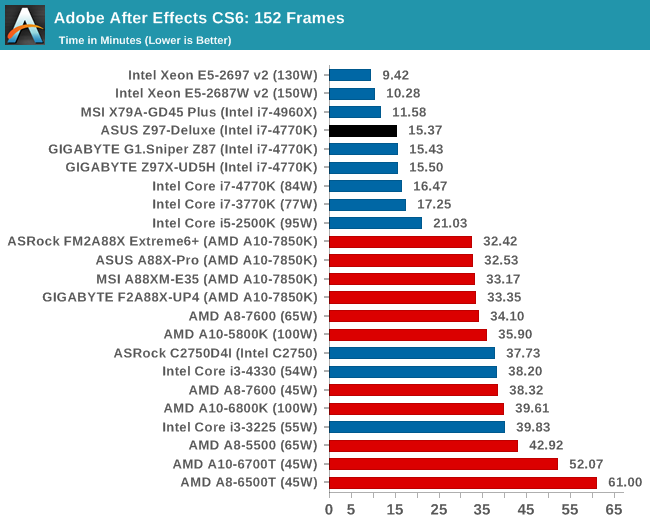
Compression – WinRAR 5.0.1: link
Our WinRAR test from 2013 is updated to the latest version of WinRAR at the start of 2014. We compress a set of 2867 files across 320 folders totaling 1.52 GB in size – 95% of these files are small typical website files, and the rest (90% of the size) are small 30 second 720p videos.
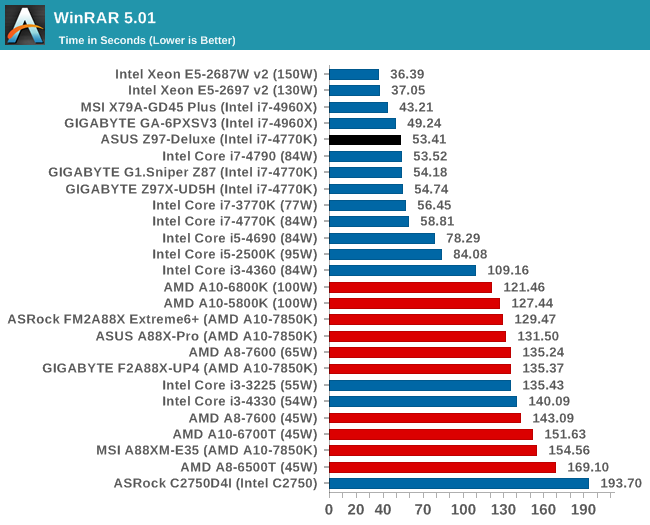
Image Manipulation – FastStone Image Viewer 4.9: link
Similarly to WinRAR, the FastStone test us updated for 2014 to the latest version. FastStone is the program I use to perform quick or bulk actions on images, such as resizing, adjusting for color and cropping. In our test we take a series of 170 images in various sizes and formats and convert them all into 640x480 .gif files, maintaining the aspect ratio. FastStone does not use multithreading for this test, and thus single threaded performance is often the winner.
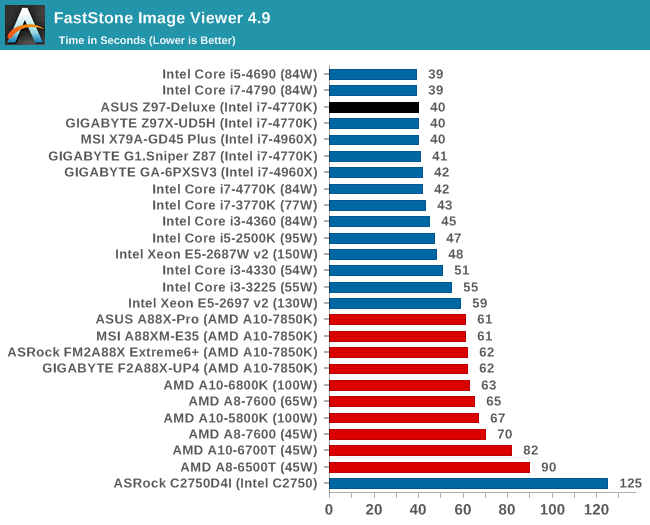
Video Conversion – Xilisoft Video Converter 7: link
The XVC test I normally do is updated to the full version of the software, and this time a different test as well. Here we take two different videos: a double UHD (3840x4320) clip of 10 minutes and a 640x266 DVD rip of a 2h20 film and convert both to iPod suitable formats. The reasoning here is simple – when frames are small enough to fit into memory, the algorithm has more chance to apply work between threads and process the video quicker. Results shown are in seconds and time taken to encode.

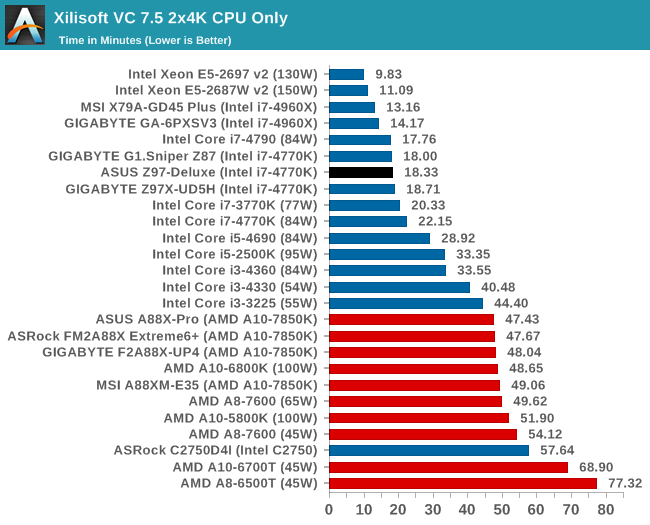
Video Conversion – Handbrake v0.9.9: link
Handbrake is a media conversion tool that was initially designed to help DVD ISOs and Video CDs into more common video formats. The principle today is still the same, primarily as an output for H.264 + AAC/MP3 audio within an MKV container. In our test we use the same videos as in the Xilisoft test, and results are given in frames per second.

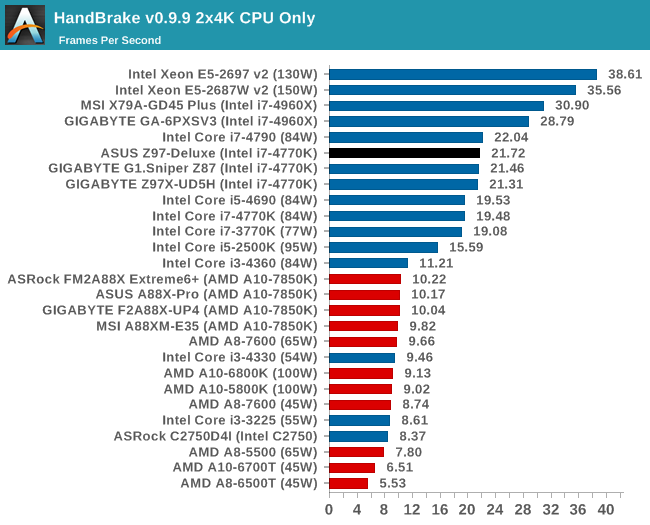
Rendering – PovRay 3.7: link
The Persistence of Vision RayTracer, or PovRay, is a freeware package for as the name suggests, ray tracing. It is a pure renderer, rather than modeling software, but the latest beta version contains a handy benchmark for stressing all processing threads on a platform. We have been using this test in motherboard reviews to test memory stability at various CPU speeds to good effect – if it passes the test, the IMC in the CPU is stable for a given CPU speed. As a CPU test, it runs for approximately 2-3 minutes on high end platforms.
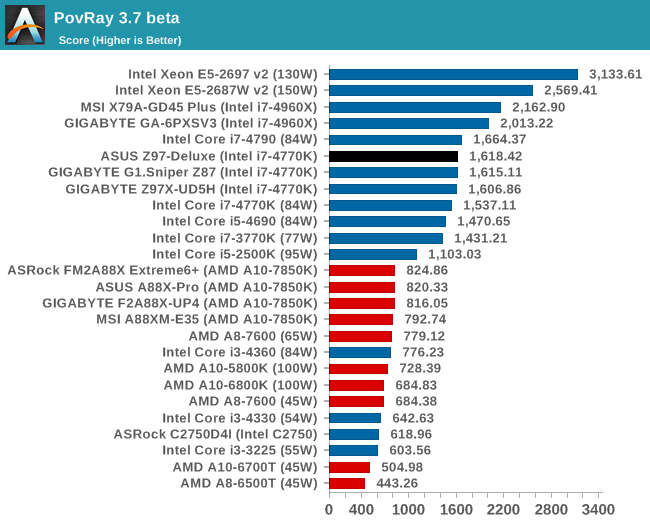










45 Comments
View All Comments
Tchamber - Monday, May 19, 2014 - link
Asus have come a long way since my last Asus board... for my old Pentium 4 CPU. This looks good, I want to upgrade when SATA Express becomes mainstream. I should think all us Star Wars fans would love this board/chipset!prophet001 - Monday, May 19, 2014 - link
Did you try booting the XP941 with this motherboard? Would love to see a Windows installation boot on it and get some benchmarks out.RamCity - Monday, May 19, 2014 - link
We just got some feedback from a customer this morning who has installed the XP941 in the ASUS Z97-Deluxe. These are the results with the latest bios dated 16th May (0901)1. With UEFI mode enabled, it's possible to begin a Windows 8 installation from DVD, but on the first reboot, the XP941 drive is not recognised, so the install couldn't proceed.
2. Customer was able to use the XP941 as storage once Windows 8 was installed to a different drive, but it doesn't show up in the list of bootable devices in the bios. He hasn't yet benchmarked the drive to see what sort of transfer speeds he can get out of it.
3. With the previous version bios, he couldn't even begin the windows installation, so it seems ASUS are working on this. Feedback we have from ASUS HQ in Europe is that they are working on getting the XP941 to boot in legacy mode.
4. The customer actually bought an ASRock Z97 Extreme6 as well and had no issues booting and installing Windows on the XP941 (installed in the M.2 socket), and confirmed it operated at full 1200/950MB/s transfer speeds.
My feeling is that it's only a matter of time before ASUS has a bios update which will allow the XP941 to have the OS installed and be bootable, but at this point it's not possible (at least from one customers point of view, and he seemed very technically astute)
Rod (vendor rep for ramcity.com.au)
prophet001 - Tuesday, May 20, 2014 - link
Thank you for the reply. Sounds exciting. Surely the floodgates are about to be opened on this technology.Timur Born - Tuesday, June 10, 2014 - link
How does audio sound once connected to speaker with 3-prong (earth line) speaker system? Like the ones that really would benefit from the audio specs written on paper, not the cheapish 2-prong desktop speaker systems.It's troubling how hard it is to find a modern mainboard that does not amplify all kinds of electronic noise (voltage) over its ground lines (anything made of metal metal), which affects both internal and external audio (PCIe, USB, FW). This is not really a ground-loop issue, but one of noisy ground lines on motherboards (while the PSU and interestingly SATA port ground remains rather clean/unamplified).